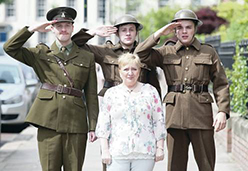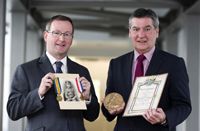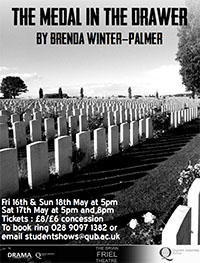My great-uncle William and the mystery behind the Death Penny
 Brenda Winter-Palmer with her students Amos McCormack, Brian Diamond and Andy Doherty who are starring in the play Medal in the Drawer.
Brenda Winter-Palmer with her students Amos McCormack, Brian Diamond and Andy Doherty who are starring in the play Medal in the Drawer.
Willie Kerr died in World War One. But, like many Catholic servicemen, his story lay wreathed in obscurity for decades. Until, that is, his great-niece decided to turn it into a play, writes Ivan Little
They called it the 'Death Penny', a bronze medal struck for the families of the hundreds of thousands of British soldiers who died in the First World War. But in Brenda Winter-Palmer's west Belfast home, the Catholic relative who never came home wasn't talked about and neither was the conflict which, for some people, was akin to a dirty little secret.
Because, like thousands of other Catholics in the west of the city, a British Army Death Penny could have been a death penalty for a soldier's relations because it was the physical embodiment of a loved one having fought for King and country during the Home Rule crisis a century ago.
Thousands of Catholics went to war in 1914 but few of the survivors who were lucky enough to come back in 1918 ever spoke of their experiences, because they feared that they would be branded as traitors to the Irish cause.
Rifleman Willie Kerr didn't return home. He was killed in action in Belgium. And that essentially was all that Queen's University drama lecturer and playwright Brenda Winter-Palmer knew about her great-uncle Willie.
Until, that is, she decided to unlock the mystery behind the Death Penny, which had been handed down from generation to generation in her family after Willie was killed in 1917 in one of the bloodiest battles of the Great War.
And now the fruits of her labour are stunning audiences in a moving new play called The Medal in the Drawer, which is being performed by drama students at Queen's in what has been the culmination of a real voyage of discovery for Brenda.
She had known virtually nothing of her great-uncle, though a wooden plaque with his Death Penny in the middle of it had always fascinated her.
"It hung in the hallway of our Andersonstown home, but all we were told by my mother was that her uncle had received it for fighting in the First World War," she says.
"Her father gave it to her because she was the one of his 12 children who polished it."
But the subject of Willie Kerr's exploits was strictly off-limits.
 "In the 1970s in west Belfast, not very many people talked freely about family connections with the British Army. We weren't a particularly nationalist family, but Willie was rarely a subject of conversation," says Brenda, who put up the Death Penny in the hallway of her home after it was passed down to her.
"In the 1970s in west Belfast, not very many people talked freely about family connections with the British Army. We weren't a particularly nationalist family, but Willie was rarely a subject of conversation," says Brenda, who put up the Death Penny in the hallway of her home after it was passed down to her.
Eighteen months ago, Brenda was approached with the idea of writing a play for the centenary of the First World War.
"I immediately thought about my great uncle Willie. And I resolved to discover more about him by talking to other relations in the first instance," she says.
What she uncovered surprised her.
For rather than joining an Irish regiment, like the Connaught Rangers, at the time of the Home Rule crisis, Willie joined Edward Carson's mainly-unionist 36th Ulster Division, along with a group of Protestant friends who used to congregate with him outside a grocery shop on the Springfield Road at the top of Forthriver Gardens.
They and Willie had been members of the Young Citizens' Volunteers, which had started off as a politically neutral militia group, but which quickly became associated with Carson, the UVF and opposition to the Home Rule movement.
Brenda realised she had stumbled on a powerful storyline around which to build a play and she went to Belgium to hunt for more clues about Willie Kerr and she followed his journey through the course of the war with his regiment, the 14th battalion, Royal Irish Rifles.
Brenda ended up at Lijssenhoek military cemetery, where Willie, who was a sniper, is buried.
He was listed as killed in action.
And at Remy Siding field hospital, Brenda was able to ascertain that he was dead on arrival, though the records there were sparse, because so many men had perished around the same time.
"I found out that Willie, who had come through the Battle of the Somme, died near St Julien during the Battle of Langemarck, which happened just before the Battle of Passchendaele."
Brenda visited the area where her great-uncle died. "It was very emotional for me – especially as I had learnt that Willie may have died from wounds he received there, because the mud was so thick that the stretcher-bearers couldn't get through to the wounded. So he might have survived if help had come more quickly," she says.
"The day that he died – August 16 – was absolute carnage. Staff at the hospital said they'd been told the dead and the injured were being brought in thick and fast."
Willie's two Protestant friends also died, one in battle, the other soon after his return to Belfast.
But Brenda was able to make contact with their relations.
"Twenty-four of them came to see the play, some of them travelling from Canada and England."
It's only in recent years, of course, that Catholics and nationalists in west Belfast have started to embrace the sacrifices made by their ancestors during the First World War.
Brenda credits the work of people like Sinn Fein's Tom Hartley in sparking the re-think that it was okay to mention the war.
"Suddenly, people in west Belfast realised they could acknowledge their losses," says Brenda, adding that people from Ireland went to war for different reasons at a time when civil war was a real possibility over the Home Rule crisis.
Many unionists thought they were helping to secure the Union by joining up.
And Brenda believes that many nationalists enlisted, because they firmly believed that the reward from the British for what they were doing would be Home Rule.
"When partition happened after the war, few wanted to admit that their family had been linked to the British Army," she says.
In her play, Brenda has used her great-uncle's real name and that of one of his friends, Tom Martin, who'd been a neighbour in Forthriver Gardens.
He was killed in a trench collapse in the lead-up to the Somme.
But Brenda agreed to change the name – but not much of the story – of another friend, who was gassed during the war and returned home, only to die on the eve of Armistice Day in November 1918. However, she has also added two fictional characters to her narrative.
Willie Kerr was just 22 when he died. And some members of Brenda's 15-strong cast are around the same age.
One of them, Matthew Jeffrey, is the nephew of the former Linfield manager David Jeffrey, who's chairman of the Barossa Somme Association and who saw the play.
He says: "It was a fantastic production and factually, historically it was right on the money. Not only did it show the tensions back then, but it was brought right up the modern day, examining how we should relate to one another. The message was massively strong."
Brenda has been humbled by the response from the audiences, which have been restricted to 25 in number at the Brian Friel Theatre at Queen's for every performance.
"That's because the action happens all around them and we have re-created a trench, which gives people the opportunity to experience what it was like for soldiers during the war," says Brenda, who hopes the play will be performed again in the future.
"I think this is a play that needs to be seen. At the end of the day, the message is that the First World War is part of a heritage that is common to both nationalists and unionists.
"And, at this time in our history, it can only be healthy to embrace that and not to hide our dead soldier boys away."
Brenda would like to produce the play in Belgium, where she visited a town called Poperinge, which was part of a small piece of unoccupied territory which soldiers visited on their downtime and did what soldiers do on their downtime.
"But there was also a place called Talbot House in Poperinge, which was run by ministers and where soldiers could enjoy rare moments of peace far away from the battlefields. The house has been preserved and it has a great atmosphere. I would like to take the play there," she says.
Brenda still has unanswered questions about her great-uncle. Unlike a number of officers who died, Willie didn't keep a diary.
"I think I have mined everything I can and I have had to use my imagination to work out what might have happened, which is the great thing about drama."
For Brenda, getting to know her great-uncle has had a major impact. "It's been like reclamation of a history that I never knew I had. And it's been a hugely emotional process for me from start to finish," she says.
Brenda admits she was as unaware of the Great War as she was about her great uncle.
"I knew the 'lions led by donkeys' cliche, about the war poets and about Frank McGuinness's masterpiece, Observe the Sons of Ulster Marching Towards the Somme. I knew about the pity of it all, but very little about the involvement on Irishmen, north and south, in the conflict," she says.
"The research was like a crash course in the contribution of Irishmen, loyalist and nationalist, to the First World War."
Brenda's play, which also charts the experiences of nationalists who joined the Connaught Rangers, marks the launch of the new Living Legacies First World War engagement centre at Queen's, one of five such bases in the UK, which aim to support community and academic research into the war as part of this year's centenary commemorations.
Brenda is also acting as community outreach officer for the new engagement centre, which will be headed up by Queen's University academic Dr Keith Lilley.
He says: "Connecting academic and public histories, the Living Legacies engagement centre will explore the enduring cultural impacts of the conflict and First World War heritage.
"Exploring the complex and sometimes divided loyalties of Irish men and women at the time, The Medal In The Drawer is a dramatic and moving way to mark the launch of our centre here in Belfast."
From a purely personal family perspective, Brenda Winter-Palmer, who's also an actress with a long list of theatre and film credits on her CV, was able to add a sad postscript to Willie's story. For his mother, Jane – Brenda's great-grandmother – simply couldn't accept that Willie was gone.
Brenda says: "For years, she would go down to the bottom of Forthriver Gardens, onto the Springfield Road, to meet him coming from Mackies, where he'd worked before the war.
"The Mackies' horn was her cue to leave the house. And every night she had to be told that Willie wasn't coming home.
"Apparently, she had completely lost her mind and died broken-hearted three years later."
Top of Page



 "In the 1970s in west Belfast, not very many people talked freely about family connections with the British Army. We weren't a particularly nationalist family, but Willie was rarely a subject of conversation," says Brenda, who put up the Death Penny in the hallway of her home after it was passed down to her.
"In the 1970s in west Belfast, not very many people talked freely about family connections with the British Army. We weren't a particularly nationalist family, but Willie was rarely a subject of conversation," says Brenda, who put up the Death Penny in the hallway of her home after it was passed down to her.
 A new play about the Belfast men who fought at the Somme and Passchendale opens to the public later this week to mark the launch of the ‘Living Legacies’ World War One Engagement Centre at Queen’s University Belfast.
A new play about the Belfast men who fought at the Somme and Passchendale opens to the public later this week to mark the launch of the ‘Living Legacies’ World War One Engagement Centre at Queen’s University Belfast.